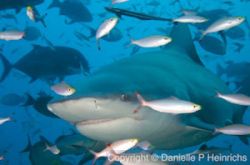
Although there are a handful of species that live in freshwater, we tend to think of sharks as being ocean dwellers. But there is also a very unique shark that can live in both ocean and fresh water estuaries and lakes: the Bull Shark.
Osmoregulation is the ability of an organism to maintain a constant concentration of water in its body even when its outside environment would normally cause it to lose or gain water. Freshwater and saltwater fish both osmoregulate.
In the organism, the external environment and the internal environment of the organism are separated by a membrane across which substances can move. This movement is on both the level of the cells, across the cell membranes, as well as on the level of the organism, across the skin. If the concentrations of water to solutes (substances that have been dissolved in the water) is unequal between the external and internal environments, water will tend to move from the area of its highest concentration to the area of lowest concentration until the concentrations are equal. This can cause organisms to either accumulate too much or too little water to maintain life. Marine animals must prevent dehydration as their environment has a high concentration of solute, while freshwater animals must conserve their salts - two opposing processes. The process of osmoregulation accomplishes this.
In sharks, the normal mechanism of osmoregulation in a marine (salt) environment is the high concentration of urea and other biological solvents in their blood and the removal of excess salt from their bloodstream through urine. The former allows them to absorb water from their marine surroundings, while the latter rids them of the salt they continually absorb. These tasks are primarily controlled by the kidneys.
In most sharks, these adaptations cannot be changed. If they are put into a freshwater environment, they will absorb too much water relative to their concentration of bodily solvents and loose too much salt to stay alive. In other words, most sharks cannot survive in fresh water because they are not capable of adapting to it.
Bull sharks are unusual because they can adapt readily to fresh water because they can adapt their process of osmogregulation. The kidneys of bull sharks, (and to a lesser extent several other types of sharks) can be gradually adjusted to suit the salinity of the water they are in. When moved gradually into freshwater (perhaps by migrating from the ocean, to an estuary, and then upriver), bull sharks' kidney's remove less salt and more urea from the bloodstream through urination, essentially reversing the normal marine shark method of osmoregulation. This adaptation allows bull sharks to live entirely in estuaries or freshwater.
They have also been seen in the Mississippi River up to St Louis, Lake Ponchartrain and the Illinois River (very rarely) up to Lake Michigan. Pretty amazing, isn't it?!
This is one of the reasons many of the shark incidents with humans (shark 'attacks') are associated with bull sharks. Bull sharks hang out in estuaries more than other sharks, which are often sites where people spend time in the water.